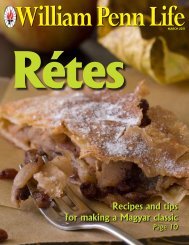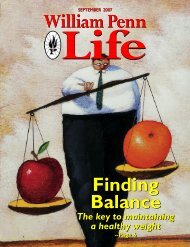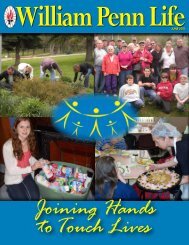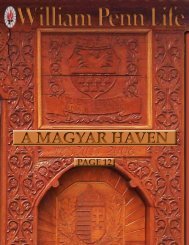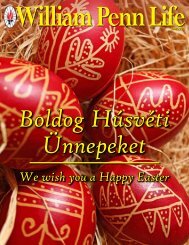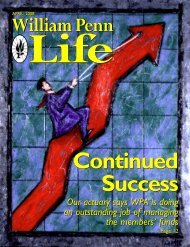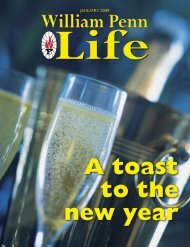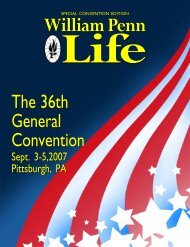Founders Day February 21 - William Penn Life
Founders Day February 21 - William Penn Life
Founders Day February 21 - William Penn Life
- No tags were found...
You also want an ePaper? Increase the reach of your titles
YUMPU automatically turns print PDFs into web optimized ePapers that Google loves.
Tibor’s Take with Tibor Check, Jr.A taste of southern cultureTHE START OF THE NEW YEAR is always a thoughtfultime for me. It is a time when, like the Roman god Janus(from where we get the name January), I look into the pastand into the future. Perhaps this is because my birthdayhappens to fall on January 1, so the arrival of each newyear is very much an occasion for change and an opportunityfor growth.This year, I turned <strong>21</strong> years of age. Instead of spendingmy <strong>21</strong>st birthday as most would, I spent it driving 12hours to rural North Carolina with my girlfriend to visither family.I jokingly told Monica (my girlfriend) that this trip wasnot about seeing her family, but rather it was for culinaryexploration. This was my first time being that far south ofthe Mason-Dixon, so I was eagerly awaiting the discoveriesthat I would make in terms of food. If there was ever atime to experience what delicacies that the Tar Heel Statehad to offer, this was it. Yet, this cultural discovery wasnot a simple one-way transaction. Being the quintessentialHungarian, I took it upon myself to be a cultural ambassadorof sorts. So, along with clothes, toiletries and othertravel items, I packed a basket of Hungarian treats forMonica’s family. With hearty helpings of kolbász, pogácsa,Egri Bikavér, and some of Erzsébet’s kifli and kalács in tow,I went south.I had never been that far away from NortheasternOhio, and I experienced a bit of culture shock.First, it was difficult for my ears to become accustomedto the thick North Carolina drawl of my hosts and mosteveryone I met there.Secondly, I had come from a land of Catholic churchsteeples. In North Carolina, the only Roman Catholicchurch that I saw could hold only 100 people at the verymost. It was a small, newly-built wooden building constructedfor the recently-arrived Hispanic immigrantpopulation. As I passed by the little church, I could nothelp but think that its average attendance would probablydwarf the turnouts during St. Margaret of HungaryChurch’s last days.Then, instead of small butcher shops, bakeries or openair markets, there were huge superstores. Whenever Itravel, I peruse local grocery stores and supermarketchains. I enjoy looking at the different local genericbrands, the different produce selections, and a few localdelicacies that are unique to the area I am visiting. InCanada, Detroit and other places in midwestern NorthAmerica, I had grown accustomed to finding a kaleidoscopeof ethnic meats, cheeses, spices, confections, pastries,canned vegetables and baked goods. I had grown upin a region where I, as an adolescent without the benefit ofa large budget or passport, had access to a wide array ofdifferent cuisines and cultures. At a grocery store in Ohio,I could buy Polish sausage, Russian tea biscuits, Greekyogurt, Lebanese hummus, Hungarian bacon, Germanchocolates, Italian sodas, Dutch cheeses and various otheritems. It took a trip down a stark, bleak aisle in a NorthCarolina Wal-Mart for me to miss and truly appreciatethe crowded, almost claustrophobic West Side Market inCleveland, Ohio.Later in the week, as my host and hostess were preparingdinner, they decided, as a courtesy, that the pogácsa Ihad brought with me would serve as a wonderful dinnerroll. They jokingly observed that they did not knowwhat to call pogácsa, whether it was a biscuit or a roll,something in between or different altogether. I repliedwith pride that such a treat was unique to we Hungarians,but soon after I conceded that it could be likened toa biscuit. Luckily, my father had recommended that I takethe cheese variety of pogácsa made by the incomparableTommy’s Pastries in Lorain, Ohio. This proved fortuitous,as the pogácsa reminded them of a southern specialtycalled a cheese biscuit.As we began to enjoy our meal, the questions soonfollowed. I was asked about Hungary, about the pogácsa,about the sausage, and about how Egri Bikavér got thename “Bull’s Blood.” It felt as if I was the only one thatwas speaking for the longest time, and I caught myselframbling more than once. I had feared that I would havebored my hosts with my asides, so I decided to start workingon my dinner.Point to Ponder....On Jan. 1, 2012, the Republic of Hungary changed its official name to simply “Hungary.” For several years now, all new Hungarianlicense plates have displayed on the left side a letter “H” with a small circle of 12 stars above it. Each star represents amember of the European Economic Union.These subtle changes are the equivalent of our country changing its name from “The United States of America’” to just“America.” And how would you like to have on your vehicle a license plate that indicates “America” is a proud member ofNAFTA? We gave away the farm when we became the main cog of NAFTA. Did the Hungarians give away the falu when theyjoined the European Economic Union?When comparing these small changes to other events taking place in Magyarorszag, these decisions are quite trivial. But,when evaluating political strategies, do these seemingly insignificant decisions point to larger and more serious implicationsdown the road? - Tibor6 º <strong>February</strong> 2012 º <strong>William</strong> <strong>Penn</strong> <strong>Life</strong>



